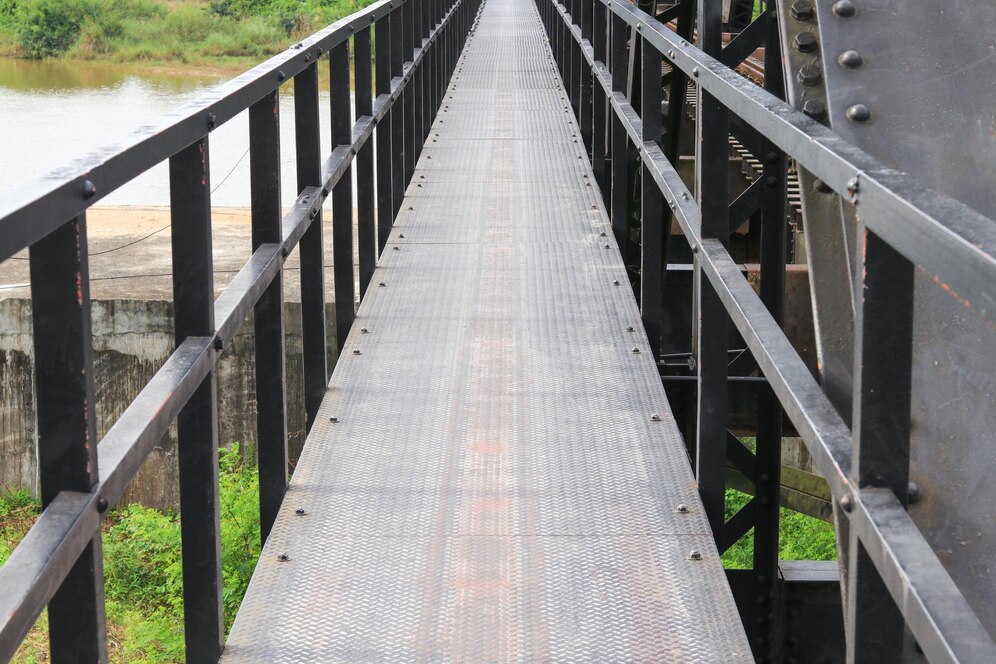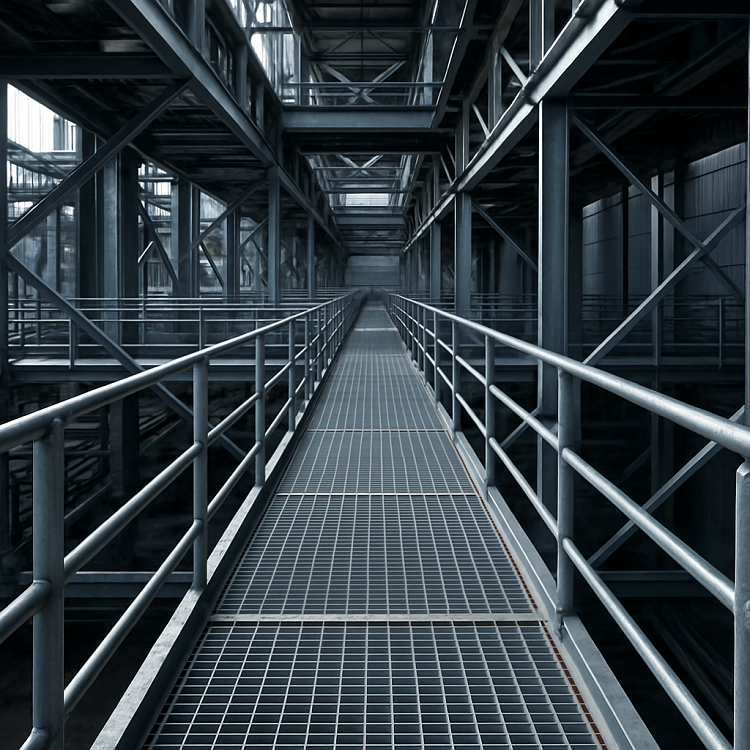How Steel Walkways Are Revolutionizing Industrial Design and Workflow Efficiency?

Steel walkways are becoming a vital part of modern industrial designs. As industries continue to evolve and expand, the need for more efficient layouts that prioritize both productivity and safety is becoming ever more important. In manufacturing plants, warehouses, factories and other industrial environments, the integration of steel walkways is helping businesses optimize their operations, improve worker safety and reduce downtime.
Steel walkways, particularly heavy-duty steel walkways and galvanized steel walkways, are designed to withstand the harsh conditions found in industrial settings. They provide durable, efficient and flexible solutions for organizing workspaces, enhancing mobility and ensuring that workers can move safely through facilities. In Uganda, as industrialization continues to rise, the role of these walkways is becoming increasingly significant in driving productivity and safety.
This guide explores the critical role of steel walkways in boosting workflow efficiency and improving safety in manufacturing and industrial environments. By understanding the features, benefits and applications of metal walkways, industries can make informed decisions on how to integrate them into their design strategies.
Steel Walkways and Its Impact on Industrial Workflow
1. Enhancing Workflow Efficiency
The integration of steel walkways in industrial environments is a game changer in terms of boosting workflow efficiency. These walkways create clear, designated paths for workers, reducing congestion and ensuring that personnel can move quickly and safely around the facility. By separating pedestrian traffic from operational zones such as machinery and storage areas, steel walkways allow workers to access various parts of the facility without interfering with production processes.
Steel walkways help in:
- Optimizing space: Elevating walkways clear valuable floor space, allowing for more efficient use of the ground level for machinery, equipment or storage.
- Streamlining access: Workers can reach different sections of a facility without disrupting operations, reducing delays in production and increasing overall efficiency.
- Facilitating smoother logistics: In larger facilities like warehouses or factories, metal walkways ensure the easy flow of personnel and goods without cross-traffic interruptions, enhancing the movement of inventory and products.
This increased organization of space not only maximizes productivity but also reduces operational inefficiencies by keeping essential pathways clear and dedicated solely to movement.
2. Steel Walkways: Improving Safety in Industrial Settings
In industrial environments, worker safety is critical. Industrial steel walkways contribute to a safer work environment by ensuring that workers have safe, designated routes to follow. These walkways are particularly beneficial in areas where machinery, hazardous materials or other safety risks are present.
Some key safety benefits include:
- Separation from hazardous zones: Steel walkways elevate workers above potentially dangerous areas such as machinery or chemical storage, minimizing the risk of accidents.
- Non-slip surfaces: Many galvanized steel walkways feature anti-slip coatings, making them safer in environments where liquids, oils or other slippery substances are present.
- Easy access to emergency equipment: Well-designed walkways allows for unobstructed access to fire exits, first aid kits and safety equipment, reducing response times during emergencies.
The ability to maintain clear pathways also reduces the risk of trips, falls and collisions between workers and equipment, which is vital in environments where heavy machinery operates.
The Benefits of Using Steel Walkways in Industrial and Manufacturing Environments
1. Durability and Strength for Metal Walkways
One of the primary reasons steel walkways are so valuable in industrial applications is their durability. Steel is a robust material capable of supporting significant weight and withstanding harsh conditions. Whether it’s heavy-duty steel walkways in a warehouse, these structures are designed to handle high levels of foot traffic, as well as heavy loads, without compromising safety or integrity.
Steel walkways can withstand:
- Heavy equipment and machinery: Steel walkways are designed to bear the weight of machinery, tools and equipment, which makes them perfect for environments where heavy machinery is frequently used.
- Harsh environmental conditions: Galvanized steel walkways, for instance, are resistant to rust and corrosion, which makes them ideal for environments exposed to moisture, chemicals or high temperatures.
This superior strength ensures a long lifespan for the walkways, reducing the need for frequent replacements and repairs and lowering maintenance costs.
2. Cost-Effectiveness and Low Maintenance for Metal Walkways
While the initial investment in steel walkways may be higher compared to other materials, they offer long-term cost benefits due to their durability and low maintenance needs. Steel, particularly galvanized steel, requires minimal upkeep, reducing the overall cost of ownership over the life of the product.
Benefits include:
- Longevity: Steel walkways can last for decades, even in the most demanding environments. Their ability to resist corrosion, damage from heavy traffic and exposure to industrial chemicals means fewer replacements or repairs are needed.
- Minimal maintenance: Regular cleaning and inspections are usually enough to maintain the structural integrity and appearance of metal walkways, saving businesses money on maintenance and repair costs.
- Return on investment: The durability and minimal upkeep required for industrial steel walkways result in a lower total cost of ownership, making them a wise investment for industrial facilities looking to save on long-term operational costs.
3. Customization for Specific Needs
Another significant advantage of steel walkway design is the ability to customize the walkways based on the specific needs of the facility. Customization allows companies to tailor the walkways to fit unique operational layouts, safety requirements and aesthetic preferences.
Customization options include:
- Size and width adjustments: Walkways can be designed to fit narrow or wide spaces, depending on the amount of foot traffic expected.
- Integration of safety features: Custom safety features such as guardrails, non-slip coatings and specific access points can be integrated into the walkway design.
- Adaptation to specific tasks: In warehouses or factories, heavy-duty steel walkways can be designed to support the additional weight of inventory, tools and machinery, while also providing a clear path for workers.
This level of customization ensures that each steel walkway is optimally designed for the specific needs of the industrial environment.

Steel Walkways in Specific Industrial Applications
1.Warehouses and Distribution Centers
In warehouses and distribution centers, the efficiency of operations is paramount. Steel walkways enhance the organization of space by providing clear paths for workers to navigate through large, complex storage areas. They also separate workers from areas where heavy equipment such as forklifts or pallet jacks are in operation, reducing the likelihood of accidents.
2. Manufacturing Facilities
Manufacturing environments often involve intricate production processes that require quick access to different areas of the facility. Industrial steel walkways ensure that workers can easily move between different production lines without disrupting the workflow. They also offer safe access to overhead equipment and machinery, enabling workers to perform maintenance tasks efficiently.
3. Chemical and Pharmaceutical Plants
For plants that deal with hazardous chemicals or pharmaceuticals, galvanized steel walkways are crucial in providing non-corrosive, non-slip paths for workers. These walkways keep personnel safe by elevating them above potentially dangerous chemicals and ensuring easy access to safety equipment and emergency exits.
How to Choose the Right Steel Walkway for Your Industrial Facility?
When selecting a steel walkway for your industrial environment, it’s essential to evaluate several factors to ensure the walkways meet the specific needs of your facility. Here are some considerations:
1. Assess the Foot Traffic and Load Requirements
- Determine the amount of foot traffic expected and the types of equipment or materials that need to be transported. Choose heavy-duty steel walkways for high-traffic areas and those that need to support heavy machinery or equipment.
2. Consider Environmental Conditions
- For areas exposed to moisture, chemicals or extreme temperatures, opt for galvanized steel walkways to prevent corrosion and ensure longevity.
3. Plan for Customization
- Work with steel walkway manufacturers who can offer tailored solutions to fit your facility’s unique design and layout requirements. Custom features such as safety rails, anti-slip surfaces and integration with existing structures may be necessary for your application.
4. Work with Reliable Steel Walkway Suppliers
- Choose suppliers with experience in providing industrial-grade steel walkways to ensure that the materials and designs are durable, safe and compliant with industry standards.
Conclusion
Steel walkways have proven to be a transformative element in industrial design. They not only improve workflow efficiency by optimizing space and reducing bottlenecks, but they also enhance safety by providing clear, non-slip and safe pathways for workers. The durability and low maintenance requirements of steel walkways make them an invaluable asset in manufacturing and industrial settings, providing long-term cost savings while ensuring that operations run smoothly and safely.
Whether it’s metal walkways for a warehouse, heavy-duty steel walkways for a factory, investing in steel walkway design is a smart choice for any business looking to improve their industrial workflow and enhance worker safety.
FAQ’s about Steel Walkways
Steel walkways provide durability, safety and improved workflow efficiency by creating designated paths for workers and equipment.
Galvanized steel walkways are coated with zinc, making them resistant to corrosion, which is essential for environments exposed to moisture and chemicals.
Yes, steel walkways can be customized in terms of size, safety features and integration with existing infrastructure to suit the unique requirements of a facility.
Steel walkways elevate workers above dangerous areas, offer non-slip surfaces and ensure easy access to emergency equipment, reducing the risk of accidents.
Yes, heavy-duty steel walkways are specifically designed to withstand high levels of foot traffic and heavy equipment use, making them ideal for demanding industrial applications.

Founder & CEO
Mukesh Patel is the Founder & CEO of Build Matt ltd, specializing in Pre-Engineered Buildings (PEB) and general steel fabrication. With advanced technology, modern machinery, and a skilled workforce, he delivers efficient and high-quality solutions across East and Central Africa, including Uganda, Kenya, Tanzania, Congo, South Sudan, Rwanda, and Burundi.
- CNC Plasma Cut Decorative Metal Panels: Revolutionizing Interior and Exterior Design
- Combining Roof Vents and Translucent Sheets for Better Airflow and Natural Lighting in Uganda Cities
- Top Design Trends in Steel Staircases for Modern Ugandan Buildings
- Steel Railings & Balustrades for Uganda Cities
- Modern Steel Silos & Hoppers : Transforming Grain Storage Efficiency in Uganda






